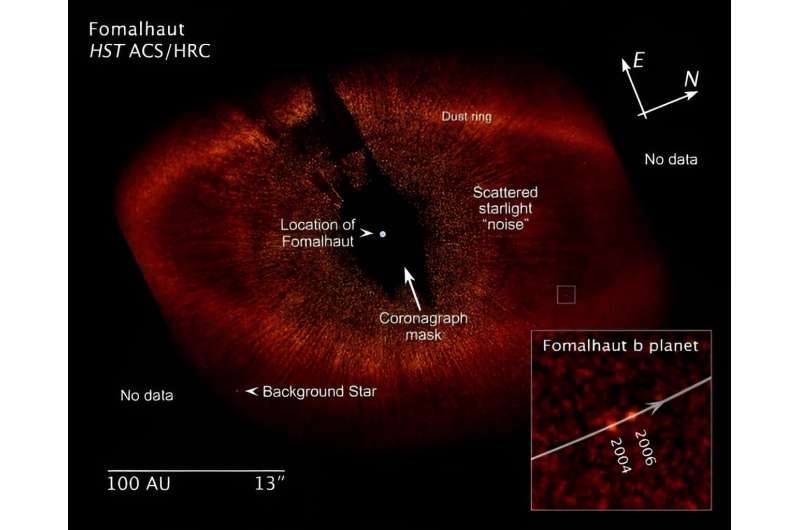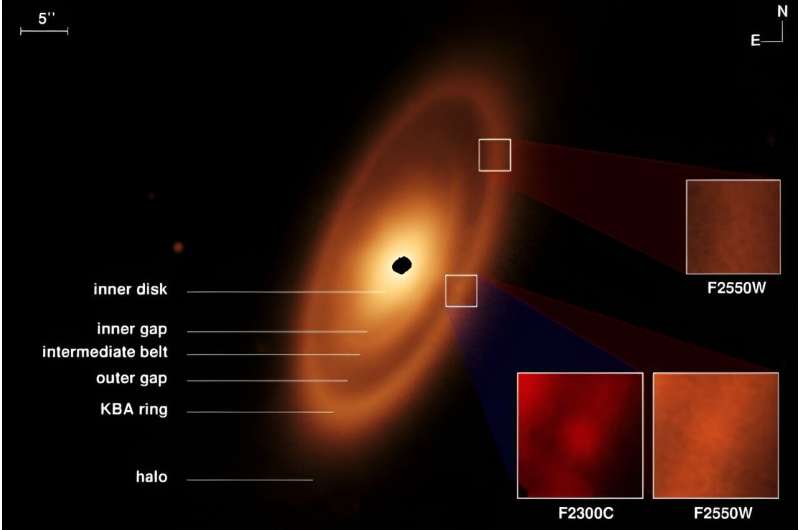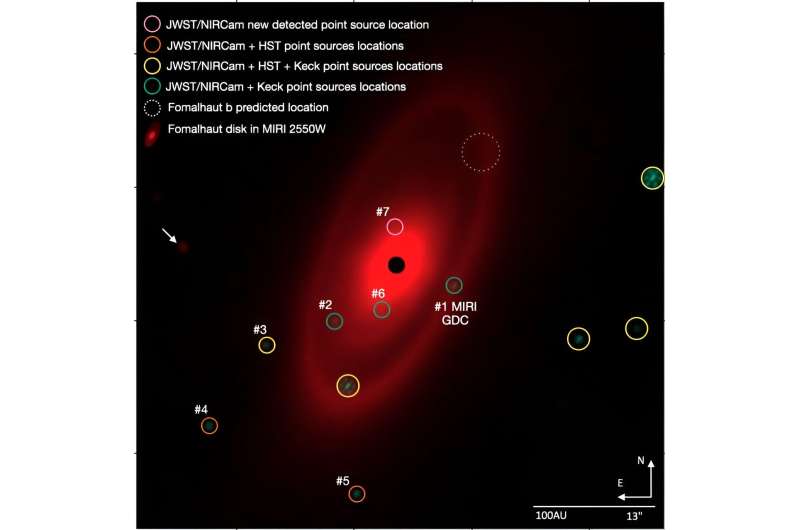This article has been reviewed according to Science X's editorial process and policies. Editors have highlighted the following attributes while ensuring the content's credibility:
fact-checked
preprint
trusted source
proofread
JWST searches for planets in the Fomalhaut system
![Fomalhaut is the brightest star in the constellation Piscis Austrinus. Credit: By IAU and Sky & Telescope magazine (Roger Sinnott & Rick Fienberg) – [1], CC BY 3.0 https://commons.wikimedia.org/w/index.php?curid=15412179 JWST searches for planets in the Fomalhaut system](https://scx1.b-cdn.net/csz/news/800a/2023/jwst-searches-for-plan.jpg)
The Fomalhaut system is nearby in astronomical terms, and it's also one of the brightest stars in the night sky. That means astronomers have studied it intensely over the years. Now that we have the powerful James Webb Space Telescope the observations have intensified.
The Fomalhaut system has a confounding and complex dusty disk, including a dusty blob. The blob has been the subject of an ongoing debate in astronomy. Can the JWST see through its complexity and find answers to the systems unanswered questions?
Like all stars this bright, Fomalhaut has been known since antiquity. Its name comes from ancient Arabic and means "mouth of the (southern) fish." That makes sense, since it's in the Piscis Austrinus (Southern Fish) constellation. Its designation is HR 8728, but in 2016 the IAU officially named it Fomalhaut.
Fomalhaut is young, only around 440 million years old. But it's consuming its hydrogen at a furious rate and may only last about 1 billion years. That's not very long in a universe where some stars will last for trillions of years. Fomalhaut has two close friends, the K-type main-sequence star TW Piscis Austrini, and the M-type, red dwarf star LP 876-10. Together they're a trinary star system.
In our modern age, astronomers have examined Fomalhaut and its complex disk. There's something dense in the disk, and astronomers have struggled to identify exactly what it is. A team of researchers observed the Fomalhaut system with the JWST's NIRCam instrument and coronagraph and published their results in the paper "Searching for Planets Orbiting Fomalhaut with JWST/NIRCam" posted to the arXiv preprint server.
In 2008, astronomers discovered a planet orbiting Fomalhaut and it took the conventional name Fomalhaut b. Then in 2012 the Hubble confirmed the object with its Advanced Camera for Surveys. But since then, there's been an ongoing debate about the object as different researchers examined the evidence and the Fomalhaut system. The idea that Fomalhaut b was an exoplanet has fallen out of favor.

Since then, the scientific consensus on the blob in the star's disk is leaning away from the exoplanet hypothesis towards the idea that it's a debris cloud. The debris could may have come from a collision between two exoplanets, and the cloud may be on an escape trajectory.
One of the difficulties in understanding the system is all of the dust. It makes observations difficult. But the JWST was built for just this situation. It can see through dust much more effectively than other telescopes with its keen infrared vision.
Webb's strength lies in its pair of instruments and their filters. NIRCam can see through dust and can see ionized gas, while MIRI can see the dust itself. Add in their filters, and astronomers can "tune" the JWST to different parts of the infrared spectrum.
This new research isn't the first time the JWST has examined Fomalhaut. In May 2023, a team of researchers used the JWST's MIRI to probe the complex dust environment around the star. They discovered a new intermediate dust belt that might be shepherded by an unseen planet. That research suggested that the blob, Fomalhaut b, could've originated in this belt.
That research also found evidence for another dust-creating collision. "We also discovered a large dust cloud within the outer ring, possible evidence of another dust-creating collision," the paper states. "Taken together with previous observations, Fomalhaut appears to be the site of a complex and possibly dynamically active planetary system."

The new research includes some of the same researchers, and this time they used the JWST's NIRCam instrument to probe the complex dust ring in different wavelengths of infrared light. This pair of studies perfectly illustrates the JWST's power and effectiveness.
These new observations seem to put the nail in the coffin for the potential-exoplanet-formerly-known-as-Fomalhaut b. "Consistent with the hypothesis that Fomalhaut b is not a massive planet but is a dust cloud from a planetesimal collision, we do not detect it in either F356W or F444W (the latter band where a Jovian-sized planet should be bright)," the authors write.
So it's a final farewell to Fomalhaut b. Or is it?
In the new observations with NIRCam and NIRSpec, the researchers detected 10 sources in the complex dusty rings. They're consistent with coronagraphic images from the HST and the Keck Telescope. "We show them to be background objects, including the "Great Dust Cloud' identified in MIRI data," they write.
But one of the 10 objects has no counterpart in previous observations. It's at the edge of the inner dust ring.

So what is #7? Is it the new Fomalhaut b?
"What is most intriguing about this object, the only NIRCam object that cannot be immediately associated with a background source, is its proximity to the inner dust disk newly identified in the MIRI imaging," the authors write. According to the research, if this is an exoplanet, it's about the same mass as Jupiter. If it is a planet, "it should have substantial dynamical interactions with the inner debris disk," they explain, but they don't see any evidence of that in these images.
"It will be important to address its possible effects on the structure of the inner disk if its planetary nature is confirmed," they write.
As this whole fascinating saga shows, confirming exoplanets in dusty rings like this is difficult. Yet it's inside these rings that planet formation takes place, and there's a lot we don't know about the process. It's one of the reasons the JWST was built.
These JWST observations can't confirm this new planet, but it may not be finished with the system yet. "Whether this object is a background galaxy, brown dwarf, or a Jovian mass planet in the Fomalhaut system will be determined by an approved Cycle 2 follow-up program," the authors explain.
Those observations will be longer duration, and that can help strengthen the signals and eliminate the noise in observations. That means smaller objects should be detectable, and "will push the detection limit from ~0.6 Jupiter masses down to ~0.3–0.4 Jupiter masses…??
The next round of JWST observations should either confirm or reject the existence of the "new" Fomalhaut b.
"In addition to confirming (or rejecting) S7 as being associated with Fomalhaut, the Cycle 2 program might identify one or more of the planets expected to exist on the basis of the complex disk structure discovered in the MIRI results," the authors conclude.
More information: Marie Ygouf et al, Searching for Planets Orbiting Fomalhaut with JWST/NIRCam, arXiv (2023). DOI: 10.48550/arxiv.2310.15028
Journal information: arXiv
Provided by Universe Today




















